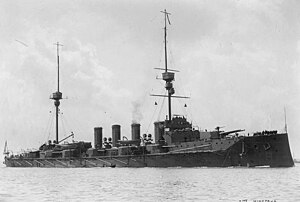 Minotaur underway with her original short funnels
| |
| History | |
|---|---|
| Name | Minotaur |
| Namesake | Minotaur |
| Builder | Devonport Dockyard |
| Laid down | 2 January 1905 |
| Launched | 6 June 1906 |
| Commissioned | 1 April 1908 |
| Decommissioned | 5 February 1919 |
| Fate | Sold for scrap, April 1920 |
| General characteristics | |
| Class and type | Minotaur-class armoured cruiser |
| Displacement | 14,600 long tons (14,800 t) |
| Length |
|
| Beam | 74.5 ft (22.7 m) |
| Draught | 26 ft (7.9 m) |
| Installed power |
|
| Propulsion | |
| Speed | 23 kn (43 km/h; 26 mph) |
| Range | 8,150 nmi (15,090 km; 9,380 mi) at 10 kn (19 km/h; 12 mph) |
| Complement | 825 (1909) |
| Armament |
|
| Armour |
|
HMS Minotaur was the lead ship of the Minotaur-class armoured cruisers built for the Royal Navy. Launched in 1906, she served as the flagship of the China Station before the First World War. Shortly after the war began, the ship searched unsuccessfully for the German East Asia Squadron and was transferred to the Grand Fleet at the end of 1914. During the rest of the war Minotaur served as the flagship of the 7th and 2nd Cruiser Squadrons and spent most of her time assigned to the Northern Patrol. In mid-1916 she participated in the Battle of Jutland but did not fire her weapons during the battle. The ship was paid off in 1919 and sold for scrap the following year.
Cite error: There are <ref group=Note> tags on this page, but the references will not show without a {{reflist|group=Note}} template (see the help page).